Pan American Airways' Aviation Mission to China: Part 3
by Eric H. Hobson, PhD
Harold Bixby had worked on Pan American Airways (PAA) President Juan Trippe’s transpacific air service dream for a year when Debby Bixby greeted him on a cold January 1934 New York City day. When Trippe sent Harold to Shanghai, China, the prior January as Special Representative to the Far East he suggested the assignment would take three to four months. But, Bixby’s twelve months in China proved his boss’ timetable naivety. While mechanical, regulatory or logistics headaches were real, thorny politics blocked transpacific expansion. Still, Bixby aimed to open Asia to PAA.
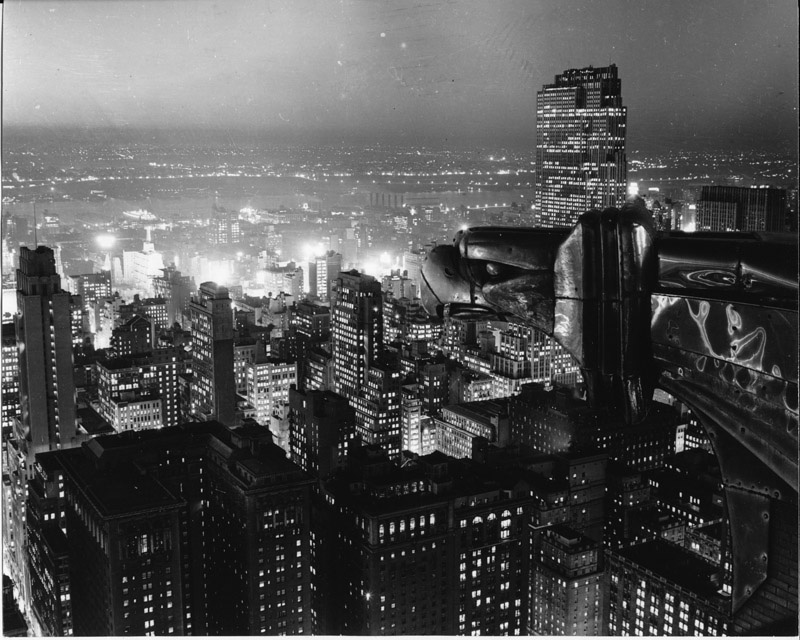
Night time view looking west, from Juan Trippe’s office on the 58th floor of the Chrysler Building, , 1930s (PAHF/ R. Fulton Collection)
Trippe had called Bixby home and Harold used the six-month stateside visit to remedy his hired-and-sent-to-the-field PAA start. He met Trippe, toured PAA’s western hemisphere operations, briefed US government officials (1), advised PAA’s executive, legal, and planning teams, before focusing on the company’s scope of business, planning, and technical innovations. All the while, Bixby prepared for the family’s move to Shanghai.
Having six Bixbys (Harold, Debby and daughters -- Frances, 18, Elizabeth, 16, Catherine, 10, and Hebe, 7) in China was essential for PAA, because as grandson, Ben Barrett, explains in The Spirit Behind the Spirit of St. Louis Harold M. Bixby, “Up until this time, when his counterparts in China asked about his family, he would be obligated to respond that they were back in the USA. That raised their eyebrows as to his dedication to any negotiations or contracts. Because the Chinese were leery of most foreigners and their motives, Harold moved his wife and four daughters there in order to indicate his dedication to the job and to confirm his commitment to see the projects through.”
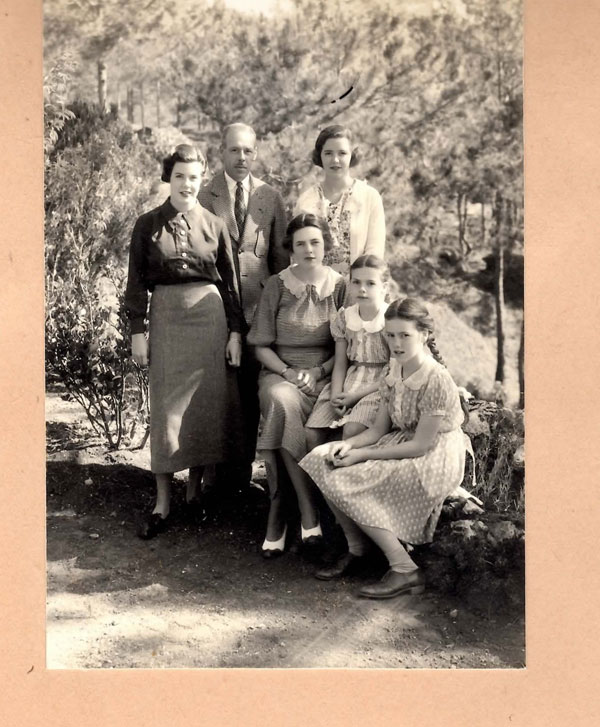
The Bixby Family, 1937 (Courtesy Bixby Family Archive)
Debby and daughters sailed to China from San Francisco in July on the President Hoover and settled into a multi-year stay that featured cultural immersion, extensive travels/sightseeing, extended family visits, and a front-row seat as twentieth-century history unfolded. Harold, meanwhile, returned to China via Europe to discuss Macao and Hong Kong landing rights with British and Portuguese officials and inspect German airplanes before flying across the Middle East and Asia on European national airlines, all the while assessing PAA’s competition. China National Aviation Corporation (C.N.A.C.) colleagues welcomed the reunited Bixby family with a bash at Columbia Country Club, Shanghai’s American expatriate community hub.
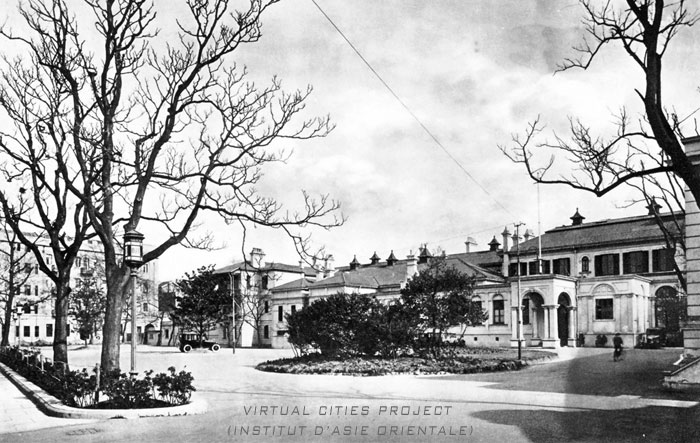
Shanghai’s Columbia Country Club, Courtesy of the Virtual Cities Project (Institut d’Asie Orientale)
https://www.virtualshanghai.net/

PAA planners betting on Harold sought US Government permission to build Pacific Ocean bases. The green light took six months, but the freighter North Haven was ready to sail on March 27 from San Francisco bearing supplies and personnel to build airline facilities on Midway Island, Wake Island, and Guam. (2)
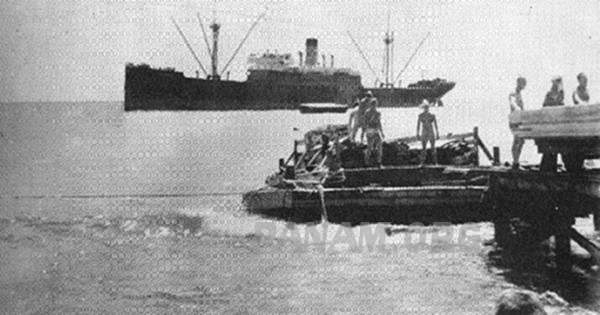 The SS North Haven Expedition (PAHF Collection)
The SS North Haven Expedition (PAHF Collection)
Harold monitored the company’s westward progress throughout spring and early summer 1935 as veteran C.N.A.C. colleague Bill Grooch’s construction teams erected full-service aviation way stations on tiny Pacific islands while crews in a modified Sikorsky S-42 (Pan American Clipper, NC-823M) flew test flights across Pacific between April and October with each flight bringing PAA’s transpacific operations closer to Harold. (3) Because PAA’s Asia team had to be ready to receive transpacific flights, Harold ceded C.N.A.C. oversight to William Langhorne Bond and family to Debby, as he spent months negotiating remaining approvals and contracts in Manila, Macao and Hong Kong.
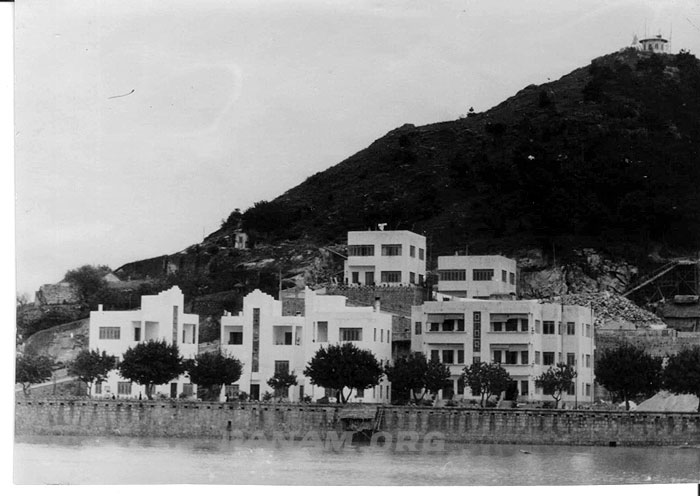 The Bixby Apartment Building in Macau c.1935 (PAHF, courtesy Frances Bixby)
The Bixby Apartment Building in Macau c.1935 (PAHF, courtesy Frances Bixby)
Harold’s August 1933 Shanghai-Manila flight and two years building PAA footholds began to pay off. Manuel Quezon was elected the Philippines’ first president on September 17, 1935 and Harold and Debby attended his swearing in and inauguration gala as the President and First Lady’s guests. Philippine legislators soon took up airspace legislation, and by mid-October, Harold forwarded a landing rights deal to Trippe which cleared transpacific survey flights through to Manila (penciled in on the corporate calendar for mid-November 1935). Access further west remained in limbo.
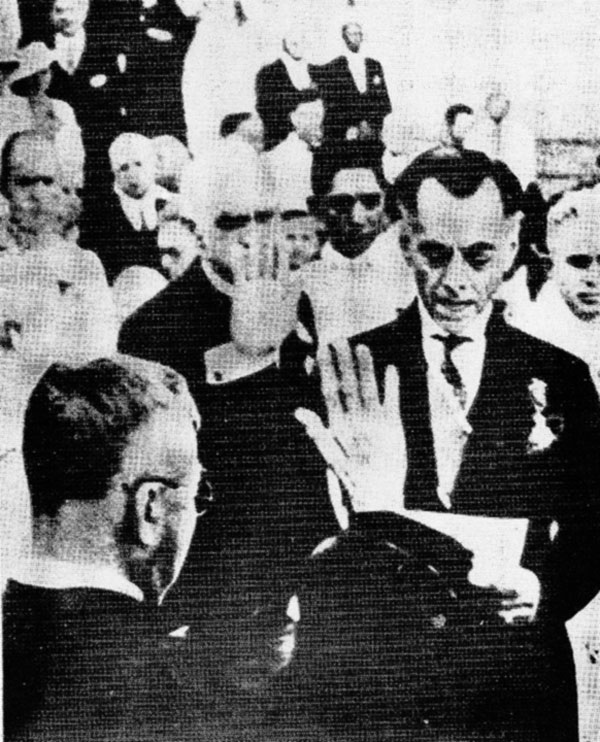
Manuel Quezon's First Inauguration (Malacañang Palace Presidential Museum and Library /Wikimedia)

Manila met PAA’s immediate needs, and its newest aircraft, a Martin M-130 (NC-14716) named China Clipper, left Alameda November 22, 1935 carrying more than 100,000 pieces of Foreign Air Mail Route 14 mail -- PAA having received the FAM14 contract in October. (4) At 3:32 p.m., Friday, November 29, 1935, Harold Bixby watched a key US-to-China aviation puzzle piece click into place when Captain Musick landed the Martin on Manila Harbor.
The Bixbys welcomed the China Clipper and celebrated PAA’s transpacific achievement. Debby Bixby recalled the day’s significance: “We and hundreds of others went up to the roof of the [Manila] hotel to watch. Finally, across the tops of the distant mountains to the south and the east appeared a distant speck. A murmur arose. My heart (and I guess all the other hearts present) began to beat very fast. The speck soon turned into a glorious and beautiful sight – the flying Clipper circling Manila, then going out to sea and coming back into the bay to land. There was a great silence and eyes were filled with tears. Then each person hugged the one next to him and everybody jumped and shouted with joy.”
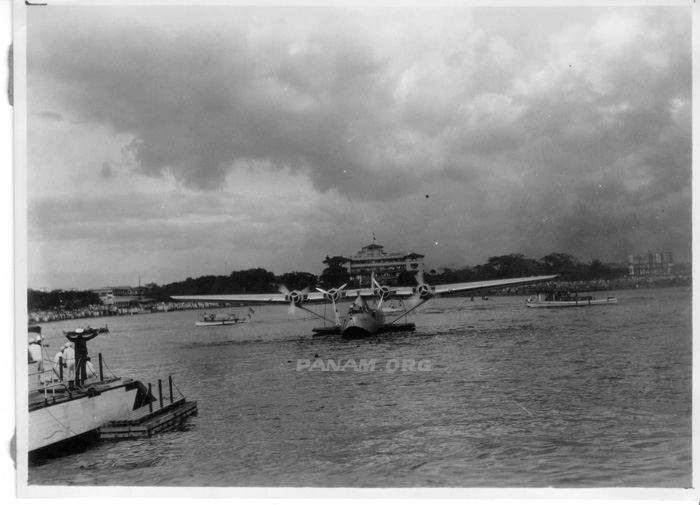
China Clipper arrives at Manila, Nov. 29th, 1935 (PAHF, courtesy Frances Bixby)
That landing represented PAA’s most audacious corporate feat to date (5), and Bixby, wearing a white linen suit and sporting a P.A.A. Staff event ribbon, stood on the PAA landing barge Bo (named after daughter, Elizabeth) amongst excited international dignitaries and locals to watch Captain Musick and crew disembark. Several months later Harold told his Amherst Class of 1913 classmates that, “During the past twelve months I have lived in a suitcase… my efforts … directed toward assisting to work out at this end some of the mechanical and political details in connection with the trans-Pacific service.” “I was in Manila when the China Clipper arrived,” he added, “and you can imagine that I got quite a kick out of seeing that ship land on the waters of Manila Bay.”
China Clipper arrival hoopla (interviews, speeches, parties, state meetings, autograph and flight-cover requests, etc.) paled to post-flight demands he managed eight years earlier for Charles Lindbergh, allowing Harold to cope while newspaper reporters and newsreel crews shared the landing and subsequent celebration with the world. The next evening, he and Debby were President Quezon’s head-table guests at a party with seating arranged in the shape of a Martin M-130. Regardless of languages spoken in the room that night, the words “Pan Am” were universal.
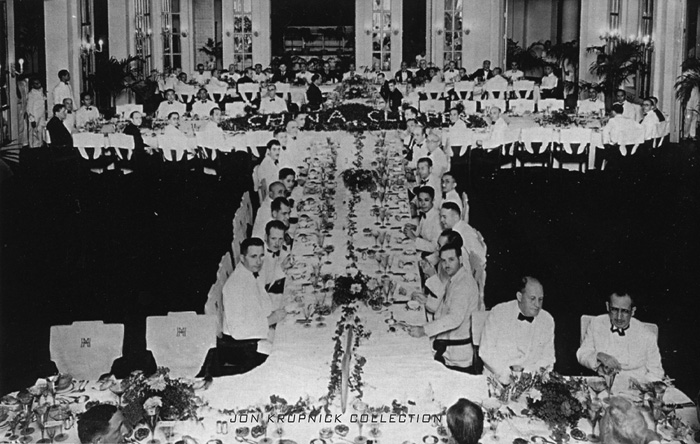
China Clipper Banquet in Manila (Courtesy Jon Krupnick Collection)

PAA had crossed the Pacific Ocean; still Harold worked without a break into 1936 because PAA routes did not reach China. PAA preferred to have its Asia transpacific-service terminus in Hong Kong; yet, the British demanded concessions PAA could not provide (Philippine landing rights was a sovereign issue). Harold returned to Macao after Christmas Day 1935 to restart negotiations, and soon presented New York a corporate New Years gift: Macao landing rights. Although Macao was backwater, PAA could move passengers to C.N.A.C. at Canton via a ferry and Harold sensed that Hong Kong’s elite would soon demand international airmail access and force their Governor to change course; until then, PAA would fly in and out of nearby Macao.
Writing to Charles and Anne Lindbergh in mid-January 1936, Bixby stated (with typical self-effacement): “My work in the Orient is nearing completion and while nothing has been accomplished of which I am very proud, nevertheless the job has been reasonably well done considering all the circumstances.” (6) Always a realist, however, Harold, knowing his transpacific project involvement was finite, also knew work remained.
He traveled constantly throughout 1936’s winter and spring while Debby and the girls mapped their own adventures. As the Alameda-Manila operation matured, and a third Martin M-130 (Hawaii Clipper, NC-14714) joined the fleet in March, airmail flowed between the two continents every ten days and, in doing so, upended long-standing communication expectations. PAA aimed to add passengers the moment Midway, Wake Island, and Guam hotels were ready: Mr. R.F. Bradley of San Francisco, holding the first passenger ticket, was ready to leave immediately.
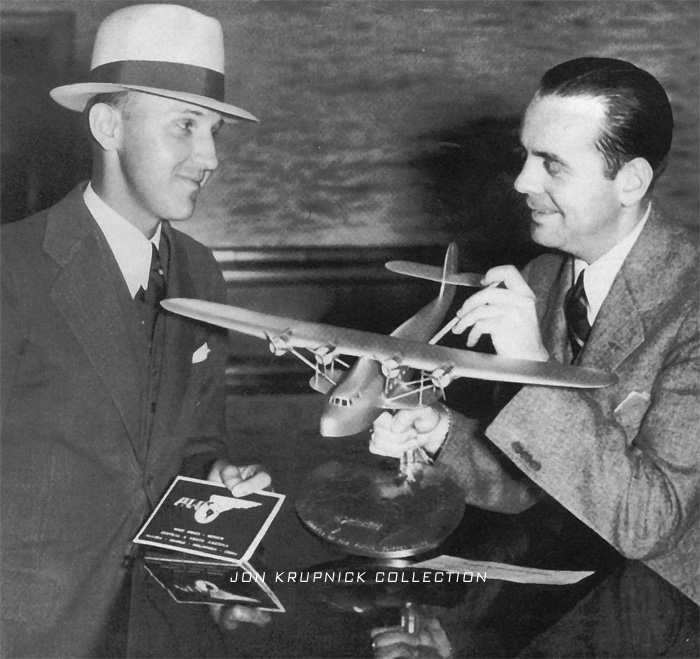 First transpacific passenger ticket holder R.F. Bradley (courtesy Jon Krupnick Collection)
First transpacific passenger ticket holder R.F. Bradley (courtesy Jon Krupnick Collection)
PAA readied for this move when Trippe ordered Bixby to New York, ASAP. Harold joined Captain Arthur LaPorte, crew, and airmail bags aboard the China Clipper on Friday morning June 19 as they headed 1,593 miles east toward Guam. He arrived at Trippe’s office in eight days, and by flying across the Pacific Ocean and North America, became the world’s first eastbound transpacific airline passenger (albeit, non-revenue generating). By July 29, Harold was aboard Captain Musick’s Hawaii Clipper -- nestled among airmail bags, newspapers, fresh food, spare parts, and sundries for PAA’s island bases, and a few PAA employees rotating to jobs along the 8,000-mile route -- arriving Manila late August 4. Harold’s globe-spanning business trip took just 6½ weeks. (7)
After disembarking Harold faced a phalanx of reporters who pressed for trip details and PAA plans but got no scoops, just Bixby’s usual, measured statements. One writer passed on that, “hotel installations at Guam, Wake, and Midway are about finished,” then added, “but he (Bixby) declined to comment as to when the company would be ready to carry passengers.”
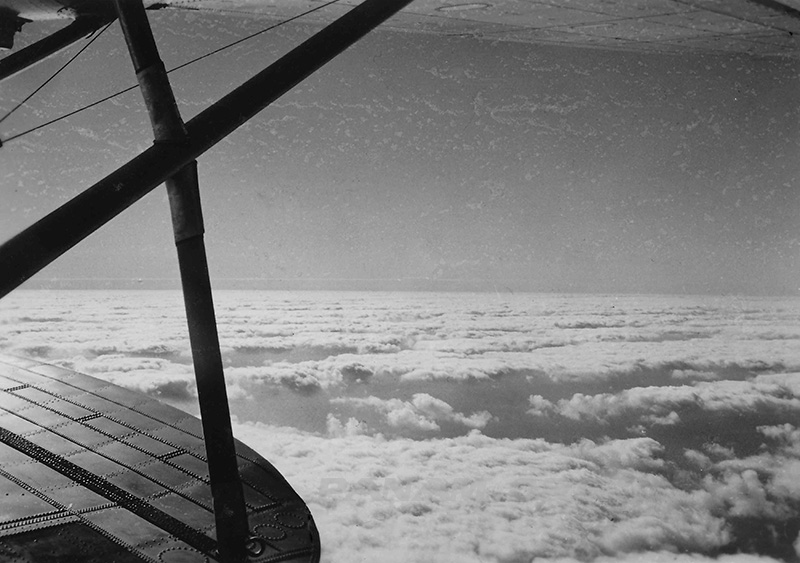
View aloft from the Hawaii Clipper (PAHF, R. Rhode Collection)
Harold Bixby knew much more than he chose to disclose that day: the inaugural transpacific passenger flight would land in Manila in about 10 weeks, and two high-profile Clipper flights would proceed it. His to-do list was still long.
Footnotes:
(1) The US State Department needed news about Japan’s colonial/military aspirations.
(2) William S. Grooch, Skyway to Asia (Longmans, Green & Co., 1936) is the project’s authoritative first-person project account.
(3) Test Flight #1: Apr 16 – 17, 1935: S.F. to Honolulu; Test Flight #2: June 12, 1935: S.F. to Hawaii to Midway; Test Flight #3: Aug 9, 1935: S.F. to Hawaii to Midway to Wake; Test Flight #4: October 5, 1935: S.F. to Hawaii to Midway to Wake to Guam.
(4) The inaugural mail load featured a letter from US President Roosevelt to Philippine President Queson that Captain Ed Musick hand-delivered.
(5) Regular transpacific mail service began at a pace of two flights per month and increased to three transits per month starting May, 1936, following PAA’s receipt of its third M-130 in March. Passenger service would not start for nearly a year.
(6) That projection was too optimistic. Harold would not leave China for another 20 months before Bixby leaves China, and not return to the US permanently for another 2½ years.
(7) Later that month he noted in his flight logbook that he had flown more than 25,000 air miles in the past two months.
Works Cited
Allen, Roy. The Pan American Clipper: The History of Pan American’s Flying-Boats 1931-1946. Barnes & Noble, 2000.
Barrett, Benjamin C. The Spirit Behind the Spirit of St. Louis Harold M. Bixby. Troy Book Makers, 2019.
Bixby, Debby. The H.M. Bixby in China 1934-1938. Self-published pamphlet (circa 1953-55). Author’s collection.
Cohen, Stan. Wings to the Orient: Pan American Clipper Planes 1935-1945. Pictorial Histories Publishing Co., 1985.
Krupnick, Jon E. Pan American’s Pacific Pioneers: A Pictorial History of Pan Am’s Pacific First Flights 1935-1946. Pictorial Histories Publishing Co., 1997.
Trippe, Betty Stettinius. Pan Am’s First Lady: the diary of Betty Stettinius Trippe. Paladwr Press, 1996.
Acknowledgement:
Thanks to Ben Barrett for publishing The Spirit Behind the Spirit of Saint Louis Harold M. Bixby which compiles materials from his grandfather’s life, for answering a host of my questions, and for providing photos to enliven this article.
Read excerpts & purchase Ben Barrett's book now available at:
https://www.thespiritbehindthespiritofstlouis.com/
Related Articles:
